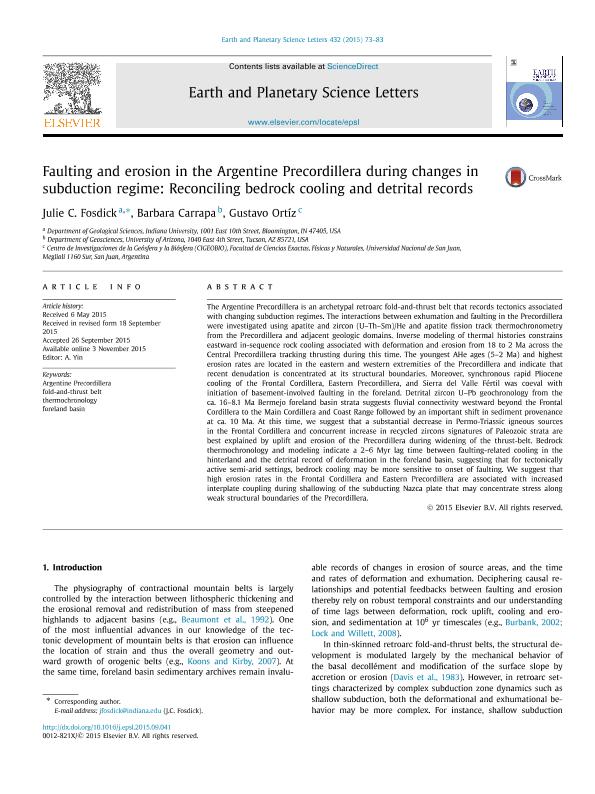Mostrar el registro sencillo del ítem
dc.contributor.author
Fosdick, Julie
dc.contributor.author
Carrapa, Barbara
dc.contributor.author
Ortiz, Gustavo Federico

dc.date.available
2018-04-23T22:11:06Z
dc.date.issued
2015-12
dc.identifier.citation
Fosdick, Julie; Carrapa, Barbara; Ortiz, Gustavo Federico; Faulting and erosion in the Argentine Precordillera during changes in subduction regime: Reconciling bedrock cooling and detrital records; Elsevier Science; Earth and Planetary Science Letters; 432; 12-2015; 73-83
dc.identifier.issn
0012-821X
dc.identifier.uri
http://hdl.handle.net/11336/43185
dc.description.abstract
The Argentine Precordillera is an archetypal retroarc fold-and-thrust belt that records tectonics associated with changing subduction regimes. The interactions between exhumation and faulting in the Precordillera were investigated using apatite and zircon (U–Th–Sm)/He and apatite fission track thermochronometry from the Precordillera and adjacent geologic domains. Inverse modeling of thermal histories constrains eastward in-sequence rock cooling associated with deformation and erosion from 18 to 2 Ma across the Central Precordillera tracking thrusting during this time. The youngest AHe ages (5–2 Ma) and highest erosion rates are located in the eastern and western extremities of the Precordillera and indicate that recent denudation is concentrated at its structural boundaries. Moreover, synchronous rapid Pliocene cooling of the Frontal Cordillera, Eastern Precordillera, and Sierra del Valle Fértil was coeval with initiation of basement-involved faulting in the foreland. Detrital zircon U–Pb geochronology from the ca. 16–8.1 Ma Bermejo foreland basin strata suggests fluvial connectivity westward beyond the Frontal Cordillera to the Main Cordillera and Coast Range followed by an important shift in sediment provenance at ca. 10 Ma. At this time, we suggest that a substantial decrease in Permo-Triassic igneous sources in the Frontal Cordillera and concurrent increase in recycled zircons signatures of Paleozoic strata are best explained by uplift and erosion of the Precordillera during widening of the thrust-belt. Bedrock thermochronology and modeling indicate a 2–6 Myr lag time between faulting-related cooling in the hinterland and the detrital record of deformation in the foreland basin, suggesting that for tectonically active semi-arid settings, bedrock cooling may be more sensitive to onset of faulting. We suggest that high erosion rates in the Frontal Cordillera and Eastern Precordillera are associated with increased interplate coupling during shallowing of the subducting Nazca plate that may concentrate stress along weak structural boundaries of the Precordillera.
dc.format
application/pdf
dc.language.iso
eng
dc.publisher
Elsevier Science

dc.rights
info:eu-repo/semantics/openAccess
dc.rights.uri
https://creativecommons.org/licenses/by-nc-nd/2.5/ar/
dc.subject
Argentine Precordillera
dc.subject
Fold And Thrust Belt
dc.subject
Thermochronology
dc.subject
Foreland Basin
dc.subject.classification
Meteorología y Ciencias Atmosféricas

dc.subject.classification
Ciencias de la Tierra y relacionadas con el Medio Ambiente

dc.subject.classification
CIENCIAS NATURALES Y EXACTAS

dc.title
Faulting and erosion in the Argentine Precordillera during changes in subduction regime: Reconciling bedrock cooling and detrital records
dc.type
info:eu-repo/semantics/article
dc.type
info:ar-repo/semantics/artículo
dc.type
info:eu-repo/semantics/publishedVersion
dc.date.updated
2018-04-17T19:57:01Z
dc.journal.volume
432
dc.journal.pagination
73-83
dc.journal.pais
Países Bajos

dc.journal.ciudad
Amsterdam
dc.description.fil
Fil: Fosdick, Julie. Indiana University; Estados Unidos
dc.description.fil
Fil: Carrapa, Barbara. University of Arizona; Estados Unidos
dc.description.fil
Fil: Ortiz, Gustavo Federico. Consejo Nacional de Investigaciones Científicas y Técnicas. Centro Científico Tecnológico Conicet - San Juan. Centro de Investigaciones de la Geosfera y Biosfera. Universidad Nacional de San Juan. Facultad de Ciencias Exactas Físicas y Naturales. Centro de Investigaciones de la Geosfera y Biosfera; Argentina
dc.journal.title
Earth and Planetary Science Letters

dc.relation.alternativeid
info:eu-repo/semantics/altIdentifier/doi/http://dx.doi.org/10.1016/j.epsl.2015.09.041
dc.relation.alternativeid
info:eu-repo/semantics/altIdentifier/url/https://www.sciencedirect.com/science/article/pii/S0012821X15006160
Archivos asociados
